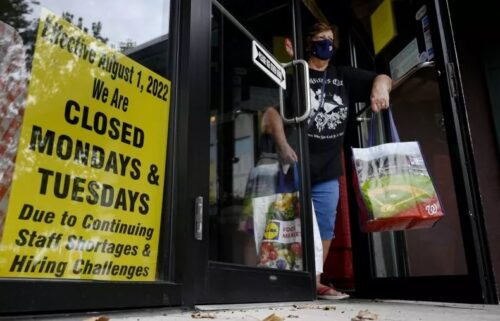8.10.23 – Newsweek – BY GIULIA CARBONARO
merica’s labor shortage continues, with the available workforce across the country remaining below levels recorded before the COVID-19 pandemic, and some states, most notably North Dakota and South Dakota, hit especially hard.
“While economists talk about the labor market cooling, there were 9.6 million job openings in June, down only 34,000 from May,” said the U.S. Chamber of Commerce’s Chief Economist Curtis Dubay in his latest analysis of the market, shared with Newsweek.
“There are now 3.6 million more job openings than unemployed workers. The worker shortage continues to be a major challenge for employers,” he added.
An estimated 50.5 million people quit their job in 2022 in a phenomenon that was dubbed the “Great Resignation.”

OLIVIER DOULIERY/AFP VIA GETTY IMAGES
According to John Blevins, a guest lecturer at Cornell University’s SC Johnson College of Business, there are a few factors that are still fuelling labor shortages in the U.S., including a decreased labor force participation rate, decreased immigration and higher than expected demand for labor because of a strong economy.
The shortfall in the number of workers has been caused by the many who quit their jobs during the pandemic to either retire, launch their own business, or take care of their family—a decline in participation in the labor market that the U.S. “is still feeling,” Blevins told Newsweek.
Many of those who quit last year were moved by the desire to find decently paid jobs that would respect their need for a better work-life balance, and were quickly re-hired elsewhere within the same sector. This is what happened in leisure and hospitality, which according to the U.S. Chamber of Commerce lost a total of 1 million workers in March 2023 and re-hired 1.1 million in the same month.
But the same thing doesn’t happen in all sectors. The labor shortage impacting the nation hasn’t gone away, as shown by the latest data from the Chamber, and still impacts a broad variety of sectors, from transportation to health care.
The sectors especially struggling with a lack of workers are durable goods manufacturing, wholesale and retail trade, and education and health services. Unlike the accommodation and food services sectors, these industries are unable to find enough skilled workers to fill all of their available job openings.
Immigration has also failed to reach pre-pandemic levels.
“It will take time for the normal flow of migrant workers to return and the U.S. is still in need of low-wage immigrant labor to take on jobs Americans will not do,” Blevins said.
The U.S. economy, despite the rise in inflation and the higher cost of living, “has proven to be extremely resilient,” he said, and remains strong.
“Consumer demand has not waned and remains a proven driver of the U.S. economy,” he added. “The quick bounce back of the economy to now surpass where it was before the pandemic has created a greater need for labor to fulfill consumer demands.”
But while the labor shortage affects the entire country, some states are struggling more than others.
Which States Are Most Affected?
The 13 states most affected by labor shortages, according to the U.S. Chamber of Commerce, are Alabama, Arkansas, Maine, Maryland, Massachusetts, Montana, Nebraska, New Hampshire, North Dakota, Oklahoma, South Dakota, Utah and Vermont.
These states are all included in the “Most Severe” category in the Chamber’s Worker Shortage index. The other categories are “More Severe,” “Severe,” “Less Severe” and “Least Severe.”
North Dakota and South Dakota have 35 available workers for every 100 job opportunities, with respectively 30,000 and 31,000 job openings, and 8,466 and 8,864 unemployed people.
Nebraska and Maryland have 40 available workers for every 100 jobs, with respectively 63,000 and 204,000 job vacancies, and 20,458 and 65,353 unemployed.
New Hampshire has 41 available workers for every 100 jobs, with 41,000 job openings and 13,466 unemployed people.
Montana, according to the Chamber, has 46 available workers for every 100 jobs, with 37,000 job openings and 13,802 unemployed people.
“The very resilient and flexible U.S. economy, with its very dynamic and mobile workforce reacts relatively quickly to economic pressures and demands. Where there are opportunities, workers will follow,” Blevins said.
“Each state can make itself amenable to these needs or not. Some states embrace a welcoming attitude to worker recruitment, while others may not,” he continued. “Different U.S. states are seeing different effects to the national U.S. labor shortage—some positive, some negative.”
Texas’ “pro-business attitude,” embraces high growth and increases in U.S. migration to Texas are a reflection of that, said Blevins.
According to the Chamber, Texas has 89 available workers for every 100 open jobs, with 846,000 job openings and 609,845 unemployed workers. It falls into the “Least Severe” category in the Worker Shortage Index.
Other states, while growing, “are losing out on the scarce labor resource to the states where the opportunities are easier and more plentiful,” Blevins said.
“Smaller states with less worker infrastructure (housing, immigration services, low cost communal services, etc) are having a harder time to attract the smaller available workforce. Those states feel the impact of reduced labor workforce participation more.” he said.
